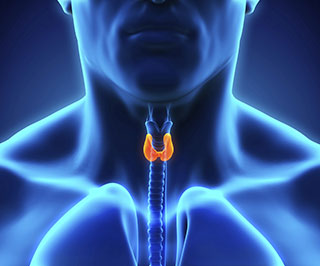 Image credit: Nerthuz/Thinkstock
Image credit: Nerthuz/Thinkstock
Significant progress has been made in treating and managing medullary thyroid carcinoma (MTC) in the last several years. As such, a task force put together by the American Thyroid Association (ATA) recently updated guidelines for diagnosis and treatment of MTC for the first time since the original guidelines were issued in 2009. The newly revised document was published in Thyroid.
Samuel A. Wells Jr., MD, of the Cancer Genetics Branch at the National Cancer Institute of the National Institutes of Health, served as lead author and chair of the task force that reviewed literature and basic science and updated the guidelines—a set of 67 recommendations—for patients who have sporadic or hereditary MTC. The task force noted that while progress has been made, much still needs to be done. Patients who have advanced disease and are treated with novel therapeutic compounds have reductions in tumor size and experience significantly prolonged progression-free-survival, but drug resistance usually develops and the tumor progresses. As such, more effective therapies are needed to help improve survival.
"The updated MTC guidelines provide a superb overview on the biology, diagnosis, and therapy of MTC. They form a state-of-the-art basis for a differentiated clinical care of patients with MTC and also highlight areas that are in need of further investigation and improvements," said Peter A. Kopp, MD, editor-in-chief of Thyroid and associate professor of medicine, in the Division of Endocrinology, Metabolism, and Molecular Medicine at Northwestern University Feinberg School of Medicine in Chicago, in a prepared statement.
The guidelines make specific recommendations for testing. For example, the recommended method for initial testing for MEN2A is either a single or multi-tiered analysis to detect RET mutations in exon 10 (codons 609, 611, 618, and 620), exon 11 (codons 630 and 634), and exons 8, 13, 14, 15, and 16. Additionally, the task force said that sequencing of the entire coding region should be reserved for situations where no RET mutation is identified, or there is a discrepancy between the MEN2 phenotype and the expected genotype.
The task force also recommends the use of genetic counseling and genetic testing in appropriate situations, such as for patients with presumed sporadic MTC, who should undergo genetic testing in order to look for a RET germline mutation. In addition, genetic counseling and genetic testing for RET germline mutations should be offered to first-degree relatives of patients with proven hereditary MTC, parents whose infants or young children have the classic phenotype of MEN2B, patients with CLA, and infants or young children with HD and exon 10 RET germline mutations, and adults with MEN2A and exon 10 mutations who have symptoms suggestive of HD.
Additionally, other than for academic reasons or physician preference, the task force said it is not standard practice to analyze tumors of patients with sporadic MTC for somatic HRAS, KRAS, NRAS mutations or RET. Measurement of carcinoembryonic antigen (CEA) is also not useful for early diagnosis of MTC.
The task force also noted items clinicians should be aware of, such as the fact that falsely high or low serum calcitonin levels can occur with a variety of diseases other than MTC, and calcitonin levels are elevated in children under 3 and especially under 6 months of age.
Thyroid tumors that have any features suggestive of MTC should have immunohistochemistry analysis to look for calcitonin, chromogranin, and CEA, and the absence of thyroglobulin. Following surgery, serum thyroid stimulating hormone (TSH) should be measured within 4-6 weeks, and replacement therapy with levothyroxine should be given with the goal of maintaining TSH in euthyroid range. Serum calcium should also be measured after surgery, and oral calcium and vitamin D should be given to people who develop symptomatic hypocalcemia.
Read the full recommendations online.